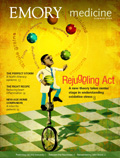New-Age Home Companion
By Dorothy Brooks
A robot named El-E may provide greater independence for patients with limited motor function
Putting robots at the disposal of patients with significant motor impairments not only could help them maintain their independence but also help relieve physical and financial burdens faced by caregivers.
In fact, such an innovation may only be a few years away from reality thanks to a project involving clinicians at Emory’s School of Medicine and engineers at Georgia Tech. Together, they developed a robot that can perform simple tasks such as opening drawers and retrieving objects. Dubbed EL-E (pronounced “Ellie”), the 5½-foot-tall machine glides across the floor on wheels and takes direction from a laser pointer that users can control in a variety of ways, depending on their preferences and capabilities. The name refers to EL-E’s arm, which moves like the trunk of an elephant.
Biomedical engineers are adding more functionality to the robot all the time by taking their cues from patients and clinicians who help them understand what types of movement and capability are needed. The resulting synergy from this working model has been a bit of a revelation to both engineers and clinicians.
“As physicians, we often don’t realize what engineers can invent and create. Many of us who work in hospitals and clinics basically use equipment and machines that are off the shelf and don’t necessarily work with the specific needs of our patients,” says neurologist Jonathan Glass, director of Emory’s ALS Clinic. “This is different. By working directly with the people who are designing these robots, we can create products that will be very useful and potentially life-changing for patients.”
Likewise, Charlie Kemp, who directs the Healthcare Robotics Lab at Georgia Tech, depends on Glass’s guidance to make sure that EL-E offers the most functionality for patients.
One of the most important insights he has gained is that there is considerable variation in how patients prefer to communicate with the robot. “To some extent, we know that if people lack dexterity in their hands, they’re going to be more likely to prefer to use a head-mounted laser pointer, and if they have high dexterity in their hands, they’re going to be more likely to prefer a hand-held laser pointer. But in the end there is still significant user preference,” he says. “What that means is that we should really be looking to develop technologies that can support lots of different user preferences easily and flexibly.”
Thus far, Kemp’s lab has designed interfaces that enable patients to control the robot through a hand-held laser pointer, a head-mounted laser pointer that is controlled through head movements, and a touch screen. Additionally, scientists are now taking advantage of speech recognition technology so that patients can give the robot verbal commands. The idea behind this approach is to model the robot after service dogs that are typically trained to understand fewer than 100 words. Kemp suggests that equipping the robot to respond to these same verbal cues is well within the capabilities of current technology.
Robots can’t offer the warmth and companionship that service dogs provide, but they don’t need to be fed and watered and can operate 24/7. Further, Glass points out that there is a long waiting list for service dogs, which are expensive to train. He expects that by the time the robot is fully developed and mass produced, it will be no more expensive than a motorized wheelchair.
Only a handful of patients from the ALS Clinic have had the opportunity to interact with the robot in a simulated living room set up in Kemp’s lab, but their response has been overwhelmingly positive. “It’s exciting to watch it work. I am just amazed,” says Norma Margeson, a Marietta, Georgia, resident who was diagnosed with ALS (amyotrophic lateral sclerosis) in 2006. “I push a button on a little hand remote and shine the laser on a telephone that is on a table,” she says. “The robot then tells me to look into its eyes and it brings the phone to my hands.”
The robot has an arm equipped with sensors so that it can determine not only how and where to retrieve items but also when to loosen its grasp. “When I would take hold of the phone, it would know that I had it and let it go,” adds Margeson.
More studies are planned in the lab, but Glass is eager to see whether the robot is sophisticated enough to negotiate the intricacies of a home environment—a milestone that is probably a year or two away. And he would like to see the robot perform more fine-motor movements. “Making this robot pick up a cup with a straw in it and hold it up to somebody’s mouth so that they can drink from it—that would be very useful,” says Glass. “I am just a dreamer here. But what I have realized is that when I dream, Charlie says ‘yes, we can do that.’ Working with the engineers at Georgia Tech has been an extraordinary experience for me and my patients.”


